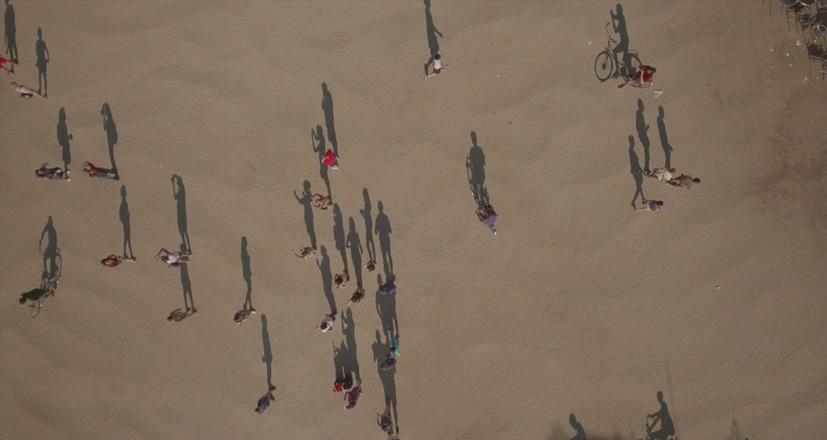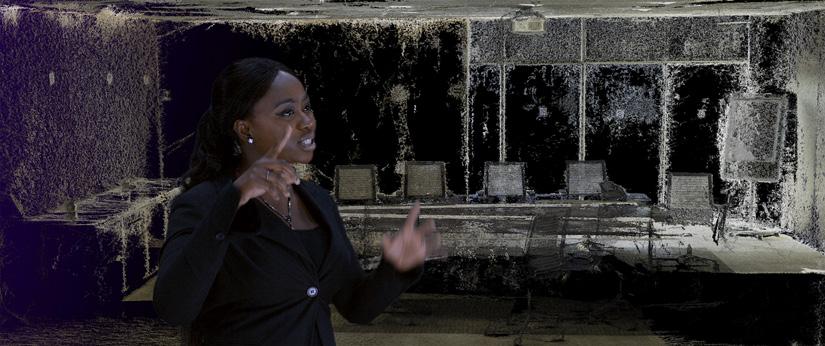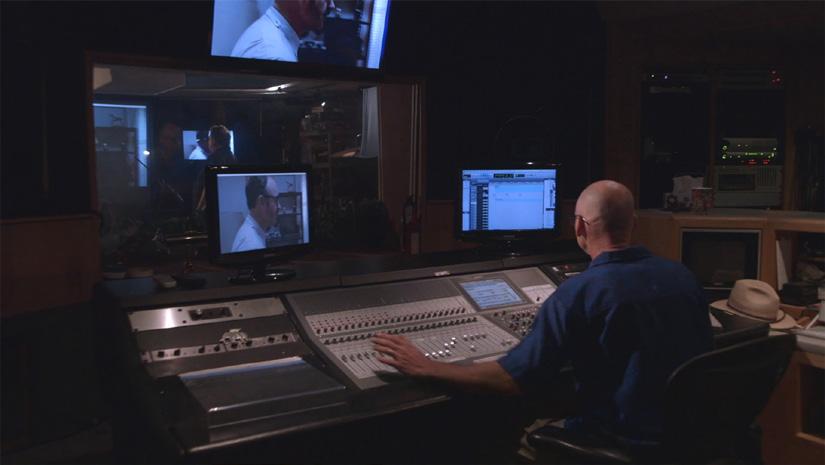
7 minute read
MONITOR: A FILM SERIES
52
Sophie Hamacher is a filmmaker and teacher who has directed, edited and produced projects ranging in genres from full-length documentary to art videos and experimental films. She received her BA from The School of the Art Institute in Chicago, holds a Meisterschüler degree in Film, Video, New Media (MFA) and an MAT in Art Education from the University of Arts in Berlin.
Advertisement
As a critical studies fellow at the Whitney Independent Study Program she wrote extensively on the relationship between art and document, and the unconscious or conscious witnessing of historical events through photography and film. Her book Supervision: On Motherhood and Surveillance is forthcoming in 2022 with Orbis Editions. She currently teaches at Maine College of Art & Design.
53
MONITOR: A FILM SERIES
PROGRAMMED BY SOPHIE HAMACHER
Seeking to update and renew the conventional “image” of surveillance, the film series MONITOR revisits surveillance in relation to its actors and techniques of observation and control. This surveillance is not limited to oppressive and authoritarian settings; instead, the films and videos included here underscore the ambiguous and contradictory nature of the surveillance we experience, as well as the indeterminate relationships it fosters. The artists and filmmakers navigate and negotiate these relationships while exploring issues of authenticity, discrimination, privacy, and depictions of power and identity.
The eighteen films and videos in the series respond to being surrounded, meditating on the ways in which our lives are shaped and regulated by watching and being watched. As a noun, “monitor” references an instrument or device—a receiver—used for observation; as a verb, it addresses the proliferation and normalization of surveillance technologies. The series includes four short programs (Oversight Machines, Modes of Enclosure, Sentenced by Sound, and Cross Examinations) and one feature length film that offer a wide spectrum of filmic approaches—from the distanced ocular perspective of a military drone to intimate interrogations of online socializing and digital anonymity —each questioning, in their own way, the systems of power entangled with the visual.
The history of the moving image is closely tied to the history of policing. One of the first instances of a camera’s use as a policing device dates back to the year 1935. 1 In Chesterfield, England police recorded a crime with a hidden 16mm camera. In the trial that followed, 14 men were convicted because of what that camera captured. Seven years later during World War II, military research yielded the first closed circuit television
54
Find, Fix, Finish by Sylvain Cruiziat & Mila Zhluktenko, 2017.

ALGO Rhythm by Manu Luksch, 2019.
55
(CCTV) cameras. 2 As film theorist Catherine Zimmer has pointed out, “the imagery that we have come to associate with surveillance has been with film from the beginning.” 3
Throughout the process of putting MONITOR together, three works that are not included in the program have served as a guide: Michael Klier’s film Der Riese (The Giant) (1982/3), the first city symphony put together entirely out of surveillance footage, Hito Steyerl’s How Not to Be Seen: A Fucking Didactic Educational .MOV File 4 (2013), a satirical instructional video demonstrating strategies for remaining “unseen” in an age of “total over-visibility”; and Terror Contagion (2021–ongoing), a film in which Laura Poitras documents Forensic Architecture’s investigation into the Israeli cyber-weapons manufacturer called NSO Group. Each of these films take a fundamentally different approach to portraying, criticizing, or encapsulating surveillance.
MONITOR showcases a range of documentary approaches, as well as staged and performative works. Complicating the idea that there is one simple, top-down way to think about surveillance, the artists and filmmakers presented in the five parts of the series are not neutral. Instead, they present divergent perspectives, using historically specific technologies.
PART ONE: OVERSIGHT MACHINES OCTOBER 8, CONGRESS SQUARE PARK
This program’s title, borrowed from a work of Abram Stern in which he painstakingly censors surveillance footage, highlights the apparatuses of visibility and control that shape our experience of the world. These mechanisms are depicted in Sylvain Cruiziat and Mila Zhluktenko’s Find, Fix, Finish (2017), Chris Kennedy’s Watching the Detectives (2017), and Manu Luksch’s ALGO Rhythm (2019). Each of these question authority and representation in various ways: from aerial perspectives, through the removal of metadata, or simply by drawing our attention to the embrace of machine intelligence and our vulnerability to manipulation through data control.
Find, Fix, Finish by Sylvain Cruiziat & Mila Zhluktenko, 2017, 19 min.
Watching the Detectives by Chris Kennedy, 2017, 33 min. (silent) ALGO Rhythm by Manu Luksch, 2019, 14 min.
56
Two siblings walk through the hallways of the Metropolitan Museum of Art looking at artifacts. The body of one is dislocated, manufactured and projected. In California, grids and prison lines are drawn. Numbers are dislodged from an administrative building in Berlin, exploding and dissipating in the air; the same city was the theater to eavesdropping and codenames a few decades earlier. Google Earth excavates pixels, blurring borders and cementing the algorithmic management of daily life with its stories of visibility and its inverse. In Dakar, Los Angeles, Boston, and Baltimore, we are confronted with complications of the seen, the known, the heard and the detectable.
57
PART TWO: ALL LIGHT, EVERYWHERE OCTOBER 14, PORTLAND MUSEUM OF ART
PART THREE: MODES OF ENCLOSURE OCTOBER 28, SPACE GALLERY
As the only feature film in the program, Theo Anthony’s All Light, Everywhere (2021) attentively explores the associations between vision, cameras, and power. Questioning the idea of objective visual evidence, this film confronts images and information weaponized by US law enforcement.
All Light, Everywhere by Theo Anthony, 2021, 1hr. 49 min.
Sondra Perry’s It’s the Game ‘17 (2018), Sarah Christman’s Dear Bill Gates (2006), Sara Zia Ebrahimi and Lindsey Martin’s The FBI Blew Up My Ice Skates (2016), Manu Luksch’s Mapping CCTV (2008), Alexander Johnston’s Evidence of the Evidence (2017), and Margaret Rorison’s One Document for Hope (2015) reflect on the role that images and their ownership play in the production of history and memory. From questions around simulations and visibility to playful interventions in the criminalization of communities of color, the films in this program examine the ways in which bodies and their representations are tracked, archived, manufactured, and ultimately enclosed.
It’s the Game ‘17 by Sondra Perry, 2018, 16 min. Dear Bill Gates by Sarah Christman, 2006, 17 min. The FBI Blew up my Ice Skates by Sara Zia Ebrahimi and Lindsey Martin, 2016, 7 min. Mapping CCTV by Manu Luksch, 2008, 3 min.
Evidence of the Evidence by Alexander Johnston, 2017, 22 min. One Document for Hope by Margaret Rorison, 2015, 7 min.
58

Hacked Circuit by Deborah Stratman, 2014 courtesy of Video Data Bank at the School of the Art Institute of Chicago.
PART FOUR: CROSS EXAMINATIONS NOVEMBER 11, SPACE GALLERY
Harun Farocki’s Prison Images (2000) is composed of images from and about prisons. The screen itself becomes a walled-in area—a rectangle similar perhaps to the walls of a cell. In Cauleen Smith’s The Grid (2011) two figures mark out a symmetrical grid around a tree with forensic tape, referencing early experiments by Robert Smithson. These geometric forms— rectangles and squares — suggest rigid systems similar to the control technologies and law enforcement in Farocki’s work. Smith’s film hints at a different, more subtle form of surveillance: the observation of the land, the earth, and the work that is put into making a grid and taking it apart again, building and breaking a framework, a network, and calling the system’s rigidity into question.
Prison Images by Harun Farocki, 2000, 60 min. The Grid by Cauleen Smith, 2011, 15 min.
59
PART FIVE: SENTENCED BY SOUND DECEMBER 9, ICA AT MAINE COLLEGE OF ART & DESIGN
Deborah Stratman’s Hacked Circuit (2014), Lawrence Abu Hamdan’s Walled/Unwalled (2018), Josh Begley’s Best of Luck with the Wall (2016), Peggy Ahwesh’s Border Control (2019), Marc Thümmler’s Radfahrer (Cyclist) (2008), and Kamal Aljafari’s It's a Long Way from Amphioxus (2019) use sound to draw attention to the camera's mechanisms of observation. In each film, we are confronted with walls and how to navigate them in a pervasive climate of government and corporate surveillance. Some films offer ways of escaping while others document how information is mined and how bureaucratic mazes are blurred, reconsidered, and uncovered.
Hacked Circuit by Deborah Stratman, 2014, 15 min. Walled/Unwalled by Lawrence Abu Hamdan,2018, 21 min. Best of Luck with the Wall by Josh Begley, 2016 7 min. Border Control by Peggy Ahwesh, 2019, 4 min. Radfahrer (Cyclist) by Marc Thümmler, 2008, 28 min. It's a Long Way from Amphioxus by Kamal Aljafari, 2019, 16 min.
1.Chris Williams/James Patterson/ James Taylor, “Police Filming English Streets in 1935: The Limits of Mediated Identification,” Surveillance & Society 6 (2009), p.3–9
2.The Siemens corporation installed the first CCTV system in 1942 in Peenemünde—Nazi Germany—for observing the launch of the first ballistic missiles. Lawrence Cappello, None of Your Damn Business: Privacy in the United States from the Gilded Age to the Digital Age (Chicago: University of Chicago Press, 2019), 171. 3. Catherine Zimmer, Surveillance Cinema: Narrative between Technology and Politics, Surveillance & Society Volume 8 No 4 (April 19, 2011): 428
4. https://www.artforum.com/video/ hito-steyerl-how-not-to-be-seen-afucking-didactic-educational-movfile-2013-51651





